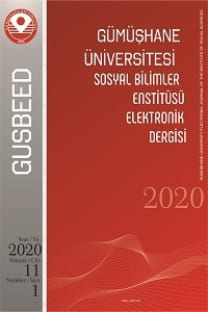Yasemin Devrimi, Kimlik ve Demokratikleşme: Tunus’ta Din ve Kimlik Algısı Üzerine Bir İnceleme
Yasemin Devrimi, Tunus, kimlik, demokratikleşme süreci
Jasmine Revolution, Identity, and Democratization: An Analysis of Religion and Identity Perception in Tunisia
Jasmine Revolution, Tunisia, identity, democratization process,
___
Aarts, P., van Dijke, P., Kolman, I., Statema, J., & Dahhan, G. (2012). From Resilince to Revolt: Making Sense of the Arab Spring. Amsterdam: Amsterdam University Press.Ayhan, V. (2012). Arap Baharı: İsyanlar, Devrimler ve Değişim. Bursa: MKM Yayıncılık.
BBC News. (2011, Ocak 11). 'Dozens killed' in Tunisia protests. Retrieved from BBC News: https://www.bbc.com/news/world-africa-12162096
BBC News. (2014, Ocak 27). Tunisia Assembly Passes New Constitution. Retrieved Haziran 2019, from BBC News: http://www.bbc.com/news/world-africa-25908340
BBC News. (2014, Ocak 9). Tunus'ta islamcı başbakan istifa etti. Retrieved Eylül 2019, from BBC News Türkçe: https://www.bbc.com/turkce/haberler/2014/01/140109_tunus_istifa
Black, I. (2010, Aralık 7). WikiLeaks cables: Tunisia blocks site reporting 'hatred' of first lady. Retrieved Ağustos 2019, from The Guardian: http://www.theguardian.com/world/2010/dec/07/wikileaks-tunisia-first-lady
Bonci, A., & Cavatorta, F. (2019). The Politics of Presidential Term Limits in Tunisia. In A. Baturo, R. Elgie, A. Baturo, & R. Elgie (Eds.), The Politics of Presidential Term Limits (179-198). Oxford: Oxford University Press.
Boulby, M. (1988). The Islamic Challenge: Tunisia since Independence. Third World Quarterly, 10(2), 590-614.
Buechler, S. (1995). New Social Movement Theories. The Sociological Quarterly, 36(3), 441-464.
Bunton, M. (2013). ‘Spring’, ‘Awakening’ or ‘Revolution’: Frames of Reference for Understanding the 2011 Arab Uprisings. Bilge Strateji, 9(5), 15-26.
Coşkun, G. (2011). Seçimlere Doğru Tunus. Uluslararası Stratejik Araştırmalar Kurumu, Ortadoğu ve Afrika Araştırmaları Merkezi. Uşak: Uluslararası Stratejik Araştırmalar Kurumu.
Coupe, J. A., & Redissi, H. (2014). Tunisia. In E. Lust (Ed.), The Middle East (789-829). London: Sage Publications.
Dahl, R. (1971). Polyarchy: Participation and Opposition. New Haven: Yale University Press.
Delaney, P. (1987, Kasım 9). Senile Bourguiba Described in Tunis. Retrieved Eylül 2019, from The New York Times: https://www.nytimes.com/1987/11/09/world/senile-bourguiba-described-in-tunis.html?scp=2&sq=senile%20bourguiba&st=cseSenile
Deutsche Welle. (2011, Mart 9). Death by fire: Self-immolation in the Arab World. Retrieved from Deutsche Welle: https://www.dw.com/en/death-by-fire-self-immolation-in-the-arab-world/a-14898706
Doğanyılmaz Duman, D. (2019). Aydınlanma Felsefesi'nde Kilise'nin Sosyo-Politik Otoritesine Karşı Tepkiler: Fransa Cumhuriyetleri ve Laik Devletin Oluşum Süreci. In R. Korlu, & G. Duman, Siyaset ve Ekonomi Üzerine Yazılar (65-84). Bursa: Ekin Yayınevi.
Duman, G. (2013). Islam and Democracy: Arab Spring and the Turkish Experience. In N. M. Adiong, International Relations and Islam: Diverse Perspectives (59-71). Newcastle upon Tyne: Cambridge Scholars Publishing.
Duman, G. (2018). An Analysis of Turkish-Tunisian Relations in Light of Arab Spring. Yıldız Social Science Review, 4(1), 53-64.
Ellali, A. (2012, Mart 25). Several Thousand Salafists Demonstrate for Islamic Law, Attack Dramatists in Tunis. Retrieved Eylül 2019, from Tunisialive: http://www.tunisia-live.net/2012/03/25/several-thousand-salafists-demonstrate-for-islamic-law-attack-dramatists-in-tunis/
Jules, T. D., & Barton, T. (2018). Educational Transitions in Post-Revolutionary Spaces: Islam, Security, and Spaces: Islam, Security and Social Movements in Tunisia. London: Bloomsbury Academic.
Kongar, E. (2016, Ekim 25). Sandık Fetişizmi ve Sivil Darbe İtirafı. Retrieved Eylül 2019, from Cumhuriyet: http://www.cumhuriyet.com.tr/koseyazisi/620869/Sandik_fetisizmi_ve_sivil_darbe_itirafi.html
Le Monde. (2014, Ocak 27). En Tunisie, la nouvelle Constitution adoptée. Retrieved Ağustos 2019, from Le Monde: https://www.lemonde.fr/tunisie/article/2014/01/26/le-premier-ministre-tunisien-a-compose-son-gouvernement_4354757_1466522.html
Linz, J. J., & Stepan, A. (1996). Problems of Democratic Transition and Consolidation: Southern Europe, South America, and Post-Communist Europe. Baltimore: Maryland: Johns Hopkins University Press.
Maktuf, L. (2013). Tunus'u Kurtarmak: Çalınan Arap Baharı. (F. E. Emcioğlu, Çev.) İstanbul: Modus Kitap.
M'rad, H. (2013, Temmuz 26). Le Dialogue National en Tunisie. Tunus: Nirvana. Retrieved Ağustos 2019, from The Independent,: http://www.independent.co.uk/news/world/africa/tunisia-shocked-by-assassinations-opposition
Özhazar, İ., ve Elbinsoy, İ. (2017). Modern Dönem İslam Ülkeleri 1. İstanbul: Tire Kitap.
Özkoç, O. (2015). Devrim’in Başladığı Yer: Sidi Bu Zeyd/Tunus. Mülkiye Dergisi, 39(2), 283-290.
Salanova, R. (2012). Social media and political change: The case of the 2011 revolutions in Tunisia and Egypt. ICIP, 7, 7-59.
Schneider, C. Q., & Schmitter, P. C. (2007). Liberalization, transition and consolidation: measuring the components of democratization. Democratization, 11(5), 59-90.
Schumpeter, J. A. (1962). Capitalism, Socialism, and Democracy. New York: Harper Torchbooks.
Szajkowski, B. (2011). Timeline of the Arab Revolt: December 2010 – June 2011. Alternative Politics, 3(3), 256-419.
The International Republican Institute. (2012). Tunisia Constituent Assembly Elections: Election Observation Mission Final Report. The International Republican Institute. Washington: The International Republican Institute.
Whitaker, B. (2010, Aralık 28). How a man setting fire to himself sparked an uprising in Tunisia. Retrieved Eylül 2019, from The Guardian: https://www.theguardian.com/commentisfree/2010/dec/28/tunisia-ben-ali
Yıldırım, R. (2017). Transformation of the Ennahda Movement from Islamic Jama'ah to Political Party. Insight Turkey, 19(2), 189-214.
Yavuz, C., ve Erdurmaz, S. (2012). Arap Baharı ve Türkiye. Ankara: Berikan.
Zelin, A. Y. (2011, Aralık 8). The Salafi Challenge to Tunisia's Nascent Democracy. Retrieved Eylül 2019, from The Washington Institute: https://www.washingtoninstitute.org/policy-analysis/view/the-salafi-challenge-to-tunisias-nascent-democracy
- ISSN: 1309-7423
- Yayın Aralığı: Yılda 3 Sayı
- Yayıncı: Gümüşhane Üniversitesi
Kalkınmanın Finansmanında Yabancı Sermaye Hareketleri ve Dış Borç Büyüme İlişkisi: Türkiye Örneği
Dış Borç ve Ekonomik Büyüme Arasındaki İlişki: Kırılgan Beşli Ülkeleri Örneği
Kişilik Özellikleri ile Güven ve Risk Arasındaki İlişki: E–Ticaret Müşterileri Üzerine Bir Uygulama
Salih YILDIZ, Ahmet KIRMIZIBİBER
Öğretmen Adaylarının Teknoloji Yeterlilikleri ile Teknolojiye Bakış Açısı Arasındaki İlişki
Mustafa AKSOĞAN, Muzeyyen BULUT ÖZEK
Yasemin Devrimi, Kimlik ve Demokratikleşme: Tunus’ta Din ve Kimlik Algısı Üzerine Bir İnceleme
Yalnızlık Ölçeğinin Okullar için Türkçe Uyarlaması
Salih DURSUN, Ahmet GÖKÇE, Sevinç DERELİ
Çok Boyutlu Sırt Çantası Problemi İçin Yeni Bir Melez Genetik Algoritma Önerisi
Hasan KÖŞKER, Nalan ALBUZ, Gözde OĞUZBALABAN
Çocukluk Çağı Travma Ölçeğinin (ÇÇTÖ) Türk Kültürüne Uyarlanması: Geçerlilik ve Güvenirlik Çalışması
